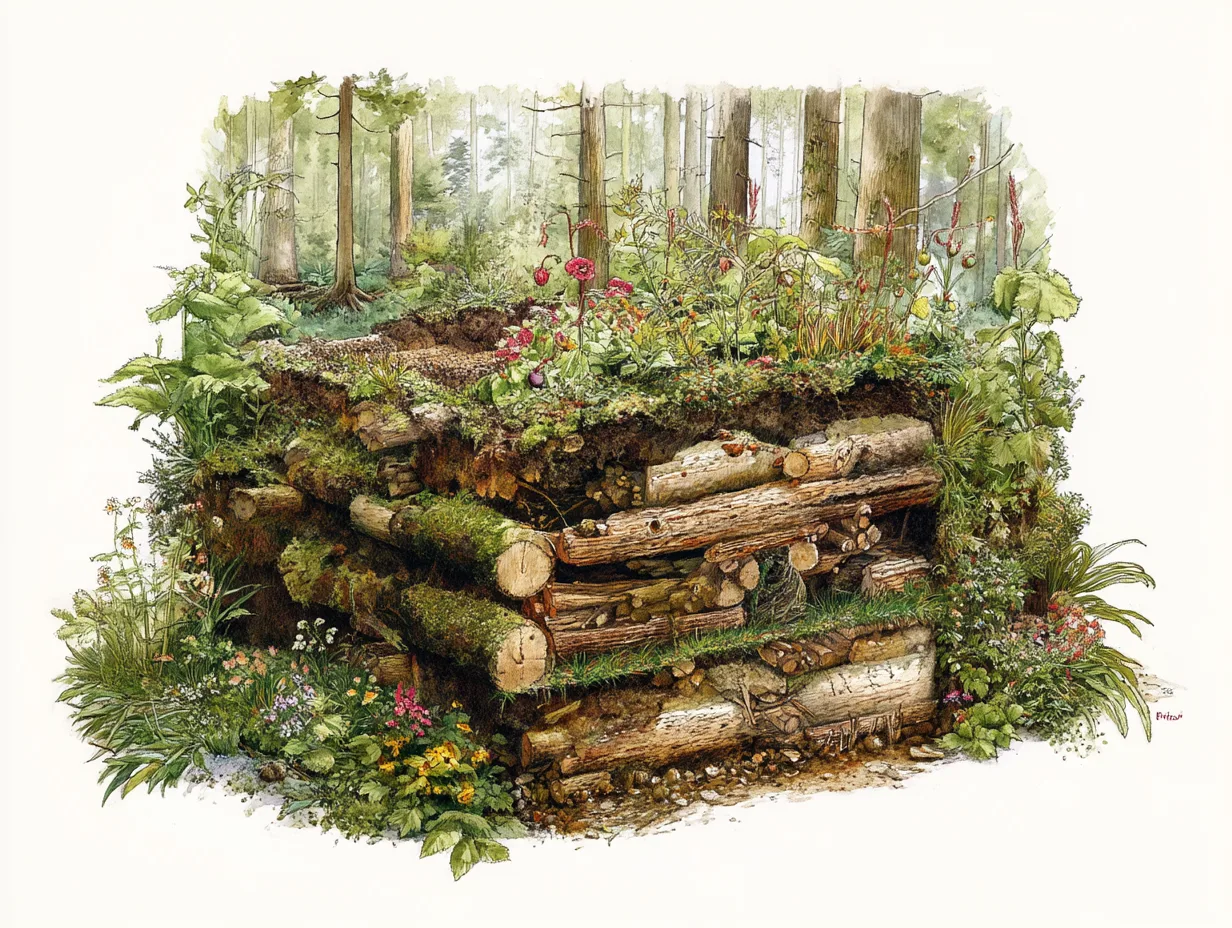Hügelkultur Gardening is a time-tested technique originating in Eastern Europe and Germany. This method involves building raised beds on top of decomposing wood and organic matter, creating a mound that provides steady nutrients, improved drainage, and enhanced soil fertility. By harnessing the natural decomposition process, Hügelkultur (pronounced “HOO-gul-culture”) beds offer a sustainable and low-maintenance approach to growing vegetables, fruits, and herbs.
In this comprehensive guide, we will explore the history behind Hügelkultur Gardening, the benefits it offers, and practical steps to create your own Hügelkultur beds. Along the way, we’ll reference helpful resources and insights from The Year-Round Vegetable Garden for Beginners, a go-to source for sustainable gardening methods.
The Origins and Principles of Hügelkultur Gardening
The term “Hügelkultur” translates directly to “mound culture” or “hill culture.” Early practitioners discovered that burying logs, branches, and other woody materials beneath the soil improved plant growth by gradually releasing nutrients as the wood decomposed. This process also traps moisture and promotes beneficial microbial activity, leading to a healthier, more productive garden bed.
Key Principles
- Layered Construction: Place rotting wood at the base, followed by layers of compostable materials like straw, leaves, and manure. Top it off with a layer of fertile topsoil.
- Decomposition Over Time: As the wood breaks down, it creates air pockets that improve root growth and nutrient uptake.
- Moisture Retention: The porous structure of decomposing wood helps retain water, reducing irrigation needs.
- Natural Heating: The composting process generates warmth, extending the growing season in cooler climates.
For more insight into building soil fertility and managing organic matter, see our guide on Composting 101.
Advantages of Hügelkultur
Hügelkultur beds offer numerous benefits, including:
- Enhanced Soil Fertility: Decomposing wood releases a steady stream of nutrients, feeding plants over several growing seasons.
- Reduced Watering Needs: The rotting wood core acts like a sponge, holding onto water and slowly releasing it to plant roots.
- Natural Waste Recycling: Hügelkultur is an excellent way to repurpose fallen branches, kitchen scraps, and yard clippings.
- Less Soil Compaction: Building a mound lifts the growing surface off the ground, improving drainage and aeration.
- Season Extension: The slow decomposition creates mild heat, helping seedlings get a head start.
Whether you’re managing a small urban plot or a larger homestead, Hügelkultur Gardening can adapt to different climates and soil types. It also pairs well with other sustainable practices like No-Dig Gardening to further enhance soil structure.
How to Build a Hügelkultur Bed
Step 1: Gather Materials
- Logs and Branches: Preferably partially rotted wood. Avoid treated or painted lumber.
- Green Material: Grass clippings, kitchen scraps, manure.
- Brown Material: Dried leaves, straw, sawdust.
- Topsoil or Compost: Final layer for planting.
- Optional: Cardboard or newspaper to suppress weeds at the base.
Step 2: Choose the Location
Select a site that receives ample sunlight. Ensure your mound won’t block pathways or create drainage issues for neighboring areas. Plan for 6–8 hours of sun per day if you’re growing sun-loving vegetables.
Step 3: Layer the Base
- Weed Suppression: Lay down cardboard or newspaper to stop grass or weeds from creeping in.
- Logs and Branches: Arrange the wood in a mound shape, roughly 2–3 feet high. Fill any gaps with smaller sticks or twigs.
- Green Material: Add a layer of grass clippings, fresh leaves, or kitchen scraps to introduce nitrogen and moisture.
Step 4: Add Brown Material
Spread dried leaves, straw, or wood chips to balance the green material. Aim for a carbon-to-nitrogen ratio that supports decomposition.
Step 5: Top It Off
Add a thick layer of fertile topsoil or compost—enough to completely cover the mound. This is where your seeds or transplants will take root. Gently compact it to reduce air pockets, but don’t overdo it.
Step 6: Water Thoroughly
Saturate the mound. This helps jump-start the decomposition process and ensures that the wood soaks up moisture.
Step 7: Plant and Mulch
Plant seeds or transplants according to their spacing requirements. Once they’re in place, add a thin layer of mulch (like straw or leaves) to conserve moisture. For detailed planting tips, refer to Vegetable Gardening for Beginners.
Maintenance and Long-Term Care
Watering
While Hügelkultur beds generally need less water, check soil moisture regularly, especially during the first year. Over time, the rotting wood holds more water, reducing irrigation frequency.
Mulching
Maintain a layer of organic mulch. This helps regulate temperature, prevent weed growth, and keep the decomposing wood moist.
Fertilizing
Initially, the wood may draw some nitrogen from the soil as it decomposes. Offset this by adding well-rotted manure or compost in the early stages, ensuring your plants have enough nutrients.
Weed Control
Weed seeds may find their way onto the mound. Hand-pull or lightly cultivate the top layer to disrupt emerging weeds. Use Eco-Friendly Pest Control methods if you encounter bugs or other garden pests.
What Can You Plant in a Hügelkultur Bed?
From leafy greens to deep-rooted vegetables, Hügelkultur beds can support a wide range of plants:
- Tomatoes, Peppers, Eggplants: The extra warmth and rich soil boost growth.
- Root Vegetables: Carrots and beets thrive in loose, aerated soil.
- Leafy Greens: Lettuce, spinach, and kale appreciate the consistent moisture.
- Companion Plants: Consider herbs or flowers that deter pests and attract pollinators.
For more on pairing crops together, see our article on Companion Planting in the Vegetable Garden.
Seasonal Tips
- Spring: Start seeds or transplants in the top layer. The decomposing wood generates mild heat, aiding germination.
- Summer: Check moisture levels during hot spells. Make sure to mulch generously.
- Fall: Add extra organic material if the mound settles. Plant cool-season crops or overwintering vegetables.
- Winter: Your Hügelkultur bed continues decomposing beneath the snow or mulch, setting the stage for improved fertility next year.
Adapting Hügelkultur to Various Climates
Hügelkultur works well in both cold and warm regions:
- Cold Climates: The internal warmth can extend the growing season. Add row covers if frost is a concern.
- Arid Regions: Wood at the core helps retain water, reducing the frequency of irrigation.
- Wet Climates: Elevated mounds provide improved drainage, preventing root rot.
For more strategies to handle diverse environmental conditions, consult Efficient Watering Techniques for Sustainable Vegetable Gardening.
Potential Challenges
- Nitrogen Drawdown: In the early stages, decomposing wood may temporarily consume nitrogen. Counter this with extra compost or manure.
- Pests: Wood piles can attract insects or small mammals. Use wire mesh if necessary, and monitor regularly.
- Settlement: The mound may slump over time. Simply add more organic material and soil to level it.
Combining Hügelkultur with Other Methods
Hügelkultur Gardening doesn’t have to be a standalone technique. You can integrate it with:
- Raised Row Gardening: Elevate your wood-filled beds further to enhance drainage and minimize labor. Check out our post on Raised Row Gardening.
- No-Dig Gardening: If you prefer minimal soil disturbance, top each season’s Hügelkultur mound with compost.
- Permaculture Principles: Hügelkultur aligns with permaculture ideals of resource recycling and natural soil building.
Why Try Hügelkultur?
Hügelkultur Gardening aligns with a sustainable mindset. It recycles organic waste, improves soil over the long term, and reduces the need for chemical fertilizers. The slow breakdown of wood and other organic matter helps create a thriving, biodiverse soil ecosystem. While the initial setup may seem labor-intensive, the payoff in reduced watering, minimal fertilization, and robust plant growth can be substantial.
By embracing Hügelkultur, you tap into an ancient method that stands the test of time—proven through centuries of use in regions where resource conservation was essential. This practice offers a greener way to cultivate food, turning potential yard waste into fertile ground.
For more advanced techniques, case studies, and expert tips, be sure to explore the rich resources in The Year-Round Vegetable Garden for Beginners. By combining Hügelkultur with other sustainable gardening methods, you can transform your plot into a resilient, productive haven for vegetables, fruits, and herbs.


Leave a Reply